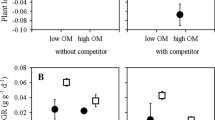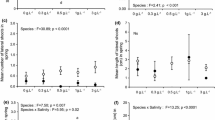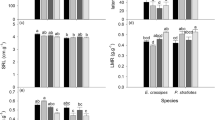Abstract
The success of an invasive plant species could be explained by trade-off between growth and defence. The aim of this paper was to explore the responses of two non-native aquatic macrophytes Elodea canadensis and Elodea nuttallii to herbivores in their introduced range. We assessed the palatability of the two phylogenetically close aquatic plant species in field and their responses to gammarid consumption in spring, summer and autumn in a microcosm experiment. We measured the variation of functional traits for each season. The traits selected were those judged most closely related to the allocation of resources to growth or to resistance against herbivores. We clearly established that the strategies of the two species were different and that their consumption rate differed in summer. In summer, E. canadensis allocated more of its resources to structural defence (leaf toughness). The increase in leaf thickness reduced the palatability of E. canadensis, whereas E. nuttallii stimulated its growth. Moreover, a decrease in dry matter content in E. nuttallii was found during the growing season in field. In autumn, both plant species accumulated nitrogen and phosphorus in their tissues. We also demonstrated that neither species induced efficient chemical defences against the herbivores. The different strategies of these two Elodea species could be explained by their different resident times in the introduced area and by an adaptation of the naturalised E. canadensis to herbivores.



Similar content being viewed by others
References
Agrawal AA, Fishbein M (2006) Plant defense syndromes. Ecology 87:S132–S149
Barrat-Segretain MH (2001) Invasive species in the Rhône River floodplain (France): replacement of Elodea canadensis Michaux by Elodea nuttallii St John in two former river channels. Arch Hydrobiol 152:237–251
Barrat-Segretain MH, Elger A (2004) Experiments on growth interactions between two invasive macrophyte species. J Veg Sci 15:109–114
Best EPH, Dassen JHA (1987) A seasonal study of growth characteristics and the levels of carbohydrates and proteins in Elodea nuttallii, Polygonum amphibium and Phragmites australis. Aquat Bot 28:353–372
Blossey B, Notzold R (1995) Evolution of increased competitive ability in invasive nonindigenous plants: a hypothesis. J Ecol 83:887–889
Blumenthal DM (2006) Interactions between resource availability and enemy release in plant invasion. Ecol Lett 9:887–895
Boiché A (2010) Conséquences de l’introduction de deux espèces végétales aquatiques exotiques (Elodea nuttallii et Elodea canadensis) sur les interactions plantes macroinvertébrés. Thesis University of Metz
Boiché A, Lemoine D, Barrat-Segretain M-H, Thiébaut G (2011) Resistance to herbivory of two populations of Elodea canadensis Michaux and Elodea nuttallii Planchon St. John. Plant Ecol 212(10):1723–1731
Cerda O, Karsten U, Rothäusler Ε, Tala F, Thiel M (2009) Compensatory growth of the kelp Macrocystis integrifolia (Phaeophyceae, Laminariales) against grazing of Peramphithoe femorata (Amphipoda, Amphithoidae) in northern-central Chile. J Exp Mar Biol Ecol 377:61–67
Cook CDK, Urmi-König K (1985) A revision of the genus Elodea (Hydrocharitaceae). Aquat Bot 21:111–156
Davis MA, Grime JP, Thompson K (2000) Fluctuating resources in plant communities: a general theory of invasibility. J Ecol 88:528–534
Di Nino F (2008) Phenoplasticité-Polymorphisme génétique-Gestion conservatoire du genre Elodea. University of Metz, Thesis
Di Nino F, Thiébaut G, Muller S (2007) Phenology and phenotypic variation of genetically uniform populations of Elodea nuttallii (Planch.) H. St John at sites of different trophic states. Fund App Limnol 168:335–343
Elger A, Barrat-Segretain M-H (2004) Plant palatability can be inferred from a single-date feeding trial. Funct Ecol 18:483–488
Elger A, Lemoine D (2005) Determinants of macrophyte palatability to the pond snail Lymnaea stagnalis. Freshw Biol 50:86–95
Elger A, Willby NJ (2003) Leaf dry matter content as an integrative expression of plant palatability: the case of freshwater macrophytes. Funct Ecol 17:58–65
Elger A, Barrat-Segretain M-H, Willby NJ (2006) Seasonal variability in the palatability of freshwater macrophytes: a case study. Hydrobiologia 570:89–93
Felker-Quinn E, Schweitzer JA, Bailey JK (2013) Meta-analysis reveals evolution in invasive plant species but little support for evolution of increased competitive ability (EICA). Ecol Evol 3(3):739–751
Fornoff F, Gross EM (2014) Induced defense mechanisms in an aquatic angiosperm to insect Herbivory. Oecologia 175:173–185
Goβner MM, Chao A, Bailey RI, Prinzing A (2009) Native fauna on exotic trees: phylogenetic conservatism and geographic contingency in two lineages of phytophages on two lineages of trees. Am Nat 173:599–614
Haine ER, Brondani E, Hume KD, Perrot-Minnot M-J, Gaillard M, Rigaud T (2004) Coexistence of three microsporidia parasites in populations of the freshwater amphipod Gammarus roeseli: evidence for vertical transmission and positive effect on reproduction. Int J Parasitol 34:1137–1146
Hanley ME, Lamont BB, Fairbanks MM, Rafferty CM (2007) Plant structural traits and their role in anti-herbivore defence. Perspect Plant Ecol Evol Syst 8:157–178
Hay ME, Kappel QE, Fenical W (1994) Synergisms in plant defenses against herbivores: interactions of chemistry, calcification, and plant quality. Ecology 75:1714–1726
Herms DA, Mattson WJ (1992) The dilemma of plants: to grow or defend. Q Rev Biol 67:283–335
Karban R (2011) The ecology and evolution of induced resistance against herbivores. Funct Ecol 25:339–347
Keane RM, Crawley MJ (2002) Exotic plant invasions and the enemy release hypothesis. Trends Ecol Evol 17:164–170
Kursar TA, Coley PD (2003) Convergence in defense syndromes of young leaves in tropical rainforests. Biochem Syst Ecol 31:929–949
Lankau RA, Rogers WE, Siemann E (2004) Constraints on the utilisation of the invasive Chinese tallow tree Sapium sebiferum by generalist native herbivores in coastal prairies. Ecol Entomol 29:66–75
Leishman M, Haslehurst T, Ares A, Baruch Z (2007) Leaf trait relationships of native and invasive plants: community- and global-scale comparisons. New Phytol 176:635–643
Lemoine DG, Barrat-Segretain M-H, Roy A (2009) Morphological and chemical changes induced by herbivory in three common aquatic macrophytes. Int Rev Hydrobiol 94:282–289
Li Y, Yu D, Yan X (2004) Are polyphenolics valuable in anti-herbivory strategies of submersed freshwater macrophytes? Arch. Hydrobiol 161:391–402
Lucas PW, Turner IM, Dominy NJ, Yamashita N (2000) Mechanical defences to herbivory. Ann Bot 86:913–920
Miler O, Straile D (2010) How to cope with a superior enemy? Plant defence strategies in response to annual herbivore outbreaks. J Ecol 98:900–907
Morrison WE, Hay ME (2011) Induced chemical defenses in a freshwater macrophyte suppress herbivore fitness and the growth of associated microbes. Oecologia 165:427–436
Mues R (1983) Species specific flavone glucuronides in Elodea species. Biochem Syst Ecol 11:261–265
Newman RM (1991) Herbivory and detritivory on freshwater macrophytes by invertebrates: a review. J N Am Benthol Soc 10:89–114
Pöckl M (1995) Laboratory studies on growth, feeding, moulting and mortality in the freshwater amphipods Gammarus fossarum and G. roeseli. Arch Hydrobiol 134(2):223–253
Prusak AC, O’Neal J, Kubanek J (2005) Prevalence of chemical defenses among freshwater plants. J Chem Ecol 31:1145–1160
Reich PB, Walters MB, Ellsworth DS (1991) Leaf age and season influence the relationship between leaf nitrogen, leaf mass per area and photosynthesis in maple and oak trees. Plant, Cell Environ 14:251–259
Siemann E, Rogers WE (2001) Genetic differences in growth of an invasive tree species. Ecol Lett 4:514–518
Smolders AJP, Vergeer LHT, van der Velde G, Roelofs JGM (2000) Phenolic contents of submerged, emergent and floating leaves of aquatic and semi-aquatic macrophyte species: why do they differ? Oikos 91:307–310
Steinberg PD (1995) Interaction between the canopy dwelling echinoid Holopneustes purpurascens and its host kelp Ecklonia radiata. Mar Ecol Progress Ser 121:169–181
Thiébaut G (2005) Does competition for phosphate supply explain the invasion pattern of Elodea species? Water Res 39:3385–3393
Thiébaut G (2007) Invasion success of non-indigenous aquatic and semi-aquatic plants in their native and introduced ranges. A comparison between their invasiveness in North America and in France. Biol Invasions 9:1–12
Thiébaut G, Di Nino F (2009) Morphological variations of natural populations of an aquatic macrophyte Elodea nuttallii in their native and in their introduced ranges. Aquat Invasions 4(2):311–320
Verges Α, Perez M, Alcoverro T, Romero J (2008) Compensation and resistance to herbivory in seagrasses: induced responses to simulated consumption by fish. Oecologia 155:751–760
Weiher E, van der Werf A, Thompson K, Roderick M, Garnier E, Eriksson O (1999) Challenging Theophrastus: a common core list of plant traits for functional ecology. J Veg Sci 10:609–620
Westoby M, Falster DS, Moles AT, Vesk PA, Wright IJ (2002) Plant ecological strategies: some leading dimensions of variation between species. Annu Rev Ecol Evol Syst 33:125–159
Acknowledgements
We are grateful to Philippe Rousselle and to Etienne Morhain for laboratory analyses. This study was supported by a doctoral research grant from the ‘Conseil Régional de Lorraine’.
Author information
Authors and Affiliations
Corresponding author
Additional information
Handling Editor: Kevin Murphy.
Rights and permissions
About this article
Cite this article
Thiébaut, G., Boiché, A., Lemoine, D. et al. Trade-offs between growth and defence in two phylogenetically close invasive species. Aquat Ecol 51, 405–415 (2017). https://doi.org/10.1007/s10452-017-9625-4
Received:
Accepted:
Published:
Issue Date:
DOI: https://doi.org/10.1007/s10452-017-9625-4




